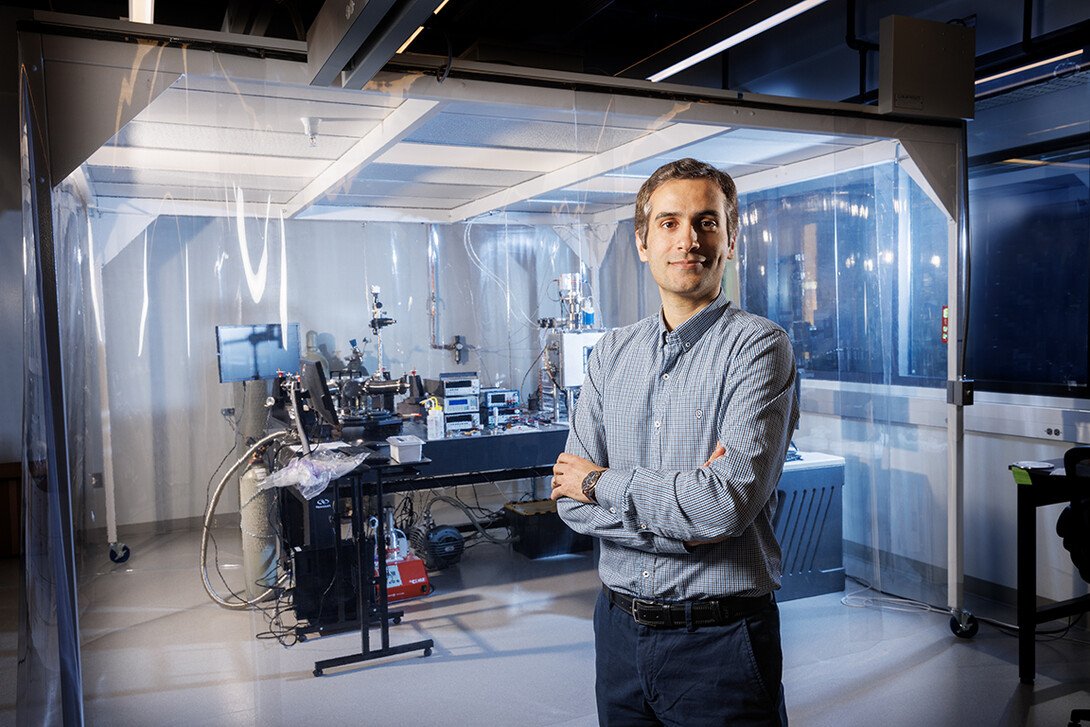
A Husker engineer is using a grant from the National Science Foundation to advance his work to understand the physics of energy transport in the miniaturized components that power today’s most prized electronics. The research has the potential to propel the development of next-generation nanodevices.
The tiny electronic parts and pieces situated within smartphones, laptops and more can experience large amounts of excess heat through a process known as near-field thermal radiation.
The University of Nebraska–Lincoln’s Mohammad Ghashami is studying this phenomenon in-depth, paving the way for strategies that would control and transform excess heat into an asset that could generate electricity, extend battery life and improve device efficiency. He recently received a five-year, $630,000 grant from NSF’s Faculty Early Career Development Program to explore the physics of near-field thermal radiation in systems with multiple components. His research is innovative for its focus on multi-body systems — to this point, the bulk of the work has focused on two-component setups — and marks one of the first attempts to experimentally verify the physics of radiative heat transfer in these systems.
The research is a key building block for developing approaches to harness excess heat in next-generation nanoelectronics, Ghashami said, because multi-body experiments more closely mirror the configuration of advanced electronic devices than two-body systems.
“The problem becomes a lot more interesting, and is a lot more realistic, if I don’t have only two objects, but multiple, and they can have different configurations, shapes and structures,” said Ghashami, assistant professor of mechanical and materials engineering. “As soon as I have more than two bodies, new physics shows up, and it changes the paradigm.
“If we can understand the physics of multi-body systems, we can come up with more efficient systems and chips that harness excess heat to produce electricity for the system.”
Under normal circumstances, a theory known as the blackbody limit governs the maximum amount of energy that can be transferred by thermal radiation. But at the nanoscale, those limits break down: When nanosized components are very close to one another, thermal transfer between them expands dramatically. That’s why early versions of laptops and other electronics were prone to overheating.
Scientists have learned to control this excessive heat to an extent — overheating and melting-induced damage are largely problems of the past — but they still don’t fully understand the physics of the phenomenon in terms of thermal radiation, particularly in multi-body systems. Laying this groundwork is key to meeting demand from the nanoelectronics community, which is keenly interested in controlling radiative heat flow in compact structures.
Ghashami’s research is at the forefront of meeting this need. His team will explore nanoscale radiative transport from a theoretical perspective, using computer modeling and software simulations to determine what is likely to happen under certain conditions. They will also become one of the first groups to conduct experimental studies of multi-body systems.
“There has been a huge gap between what our power is in terms of theoretical calculations, and what we can do and verify experimentally,” Ghashami said. “What distinguishes this work is that we are not only trying to understand multi-body physics, but we are trying to do experimental verification and study of the structural factors that impact this multi-body radiation.”
The reason for the gulf is the physical difficulty of setting up the experiments. Researchers struggle to accurately mimic the tiny gaps between objects at the nanoscale, which are a thousand times narrower than the width of a human hair.
To overcome this, Ghashami’s group is developing a first-of-its-kind experimental platform that will enable his group to control the minuscule gaps between multiple samples. Using the setup, they will be able to achieve and control gap distances smaller than 100 nanometers and test a variety of materials, configurations and structures. The team will build the platform at the Nebraska Nanoscale Energy Engineering Lab, which is Ghashami’s laboratory.
Ghashami hopes the ability to conduct experiments with such broad parameters will pave the way for developing increasingly efficient nanoelectronics, with potential applications in aerospace electronics, biomedical sensors and low-electricity information processors. His team is also eyeing the development of a thermally activated transistor, in which heat, rather than electricity, would control the current running through a device.
For the educational component, Ghashami will launch a course that connects Husker students to high-tech industry partners. He tapped his network and found scientists from companies like Intel, Qualcomm and Texas Instruments to present to students for 30 to 45 minutes on a nanoscience topic. Each week will feature a different company.
Ghashami believes it is one of the first classes at the university to provide students with an in-depth view of how science unfolds in the industry setting.
“Sometimes, we are far away from what real industry is using,” Ghashami said. “This part brings us closer to what is actually being done in the real world. Our graduate and senior undergraduate students can attend the classes, learn and also increase their professional network, giving them a better chance to get an internship.”
The course will be open remotely to students at Navajo Technical University in New Mexico.
The National Science Foundation’s CAREER award supports pre-tenure faculty who exemplify the role of teacher-scholars through outstanding research, excellent education and the integration of education and research.







